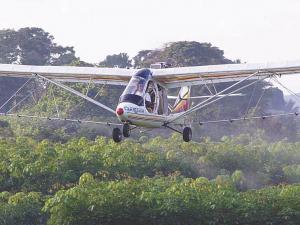2008 - Volume #32, Issue #5, Page #25
[ Sample Stories From This Issue | List of All Stories In This Issue | Print this story
| Read this issue]
Ultralight Crop Sprayer Provides Low-Cost Application
 |
"We had a wet year and couldn't get into the fields to spray," he recalls. "All the crop dusters were booked. We saw an article on spraying with an ultralight and bought one."
Ellefson sprayed thousands of acres of soybeans, sunflowers and wheat with the rig. "It paid for itself that year alone, and we would have kept using it, but it had problems with nozzles plugging up," he says. "As it was, we used it for three years before I left the farm to work in the ultralight industry."
Now Ellefson is promoting a new sport plane, the GT500 from QuickSilver Mfg., and a matching controlled droplet spray system. The company claims it will cover six acres per minute or as much as 150 acres per hour, depending on speed and rate. What makes that possible with only a 32-gal. tank is a 90 percent reduction in water use and a claimed 90 percent better coverage. The boom length of 28 ft. will generally cover a spray width of 60 ft., says Ellefson.
"When spraying, you fly only 5 to 10 ft. above the crop at speeds of about 50 miles per hour," he explains. "The turbulence created by the plane and the specially designed nozzles with their propeller drives create 50 to 300 micron droplets, and force them under and around leaves."
Ellefson notes that coverage is so fast and at such a low cost per acre that multiple applications can be made if the first application doesn't do the job.
Quicksilver claims application costs for the GT500 of as low as 28ó/acre, suggesting this can provide a savings of as much as 73 percent per acre over a commercial applicator. Costs again depend on application rates.
The GT500 with spray system is priced at $42,795. Ellefson says the 38-lb. spray system was custom designed for the GT500 with the tank placed in what is otherwise a rear seat.
The GT500 can be equipped with floats for water landing and take offs. It is equipped with a full size instrumentation panel with navigational avionics and a rocket deployed parachute designed to lower the entire aircraft with pilot and passenger.
While only a few plane kits and spray systems have been sold to date, Ellefson expects the number to increase dramatically. Two reasons are improvements the company has made to its spray system and FAA standards.
"Our new spray nozzles eliminate the plugging problems I ran into on our farm," he says. A bigger problem has been FAA certification.
In the past, says Ellefson, FFA inspectors tended to interpret the rules differently. He reports the company now has documentation that should streamline applications. He admits the company is just getting its feet wet with this application in the U.S., though the system is in use in Latin America.
The plane comes as a "to be assembled" kit. Ellefson says they are easy to build with 95 percent of the holes predrilled and no bending or other major fabricating to be done.
Ellefson says the minimum requirement for the GT500 is a sport pilot license which requires 20 hours of training, 15 dual and five solo. However, due to recent rule changes the amount of training required is unclear at this time.
"It's possible that a farmer making applications may need a private pilot's licenses which requires 40 hours of flight time," he says. "He would also need the same ag permits he would if spraying on the ground."
Contact: FARM SHOW Followup, Todd Ellefson, Quicksilver Mfg., 6589 Chippewa Lane N.W., Rochester, Minn. 55901 (ph 507 208-0111; skyrider1@charter.net; www.quicksilveraircraft.com).

Click here to download page story appeared in.

Click here to read entire issue
To read the rest of this story, download this issue below or click here to register with your account number.




